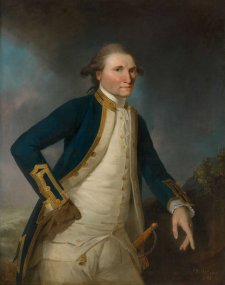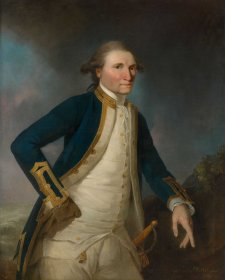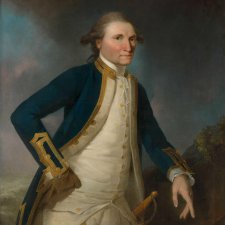- About us
- Support the Gallery
- Venue hire
- Publications
- Research library
- Organisation chart
- Employment
- Contact us
- Make a booking
- Onsite programs
- Online programs
- School visit information
- Learning resources
- Little Darlings
- Professional learning
James Cook (1728–1779), maritime explorer, closed the yawning gap in the map of New Holland when he sailed up its east coast between April and August 1770 during the first of three voyages to the Pacific. He made meticulous charts of the bays, rivers and islands he passed, and gave the name New South Wales to the eastern seaboard of the continent. Cook was almost continually at sea between 1768 and 1779, scrutinising vast areas that had previously been only tentatively investigated, and ultimately effecting world-changing consequences for the First Nations peoples and cultures of the entire Pacific region. Accounts produced from his voyages provided Europeans with their first glimpse of the culture, wildlife and geography of lands as diverse as Tahiti and Alaska.
Twenty-four when he was offered the opportunity to join Cook's third voyage, artist John Webber left Plymouth in July 1776. Between this time and his return to England in 1780, Webber made about 200 drawings and watercolours of topographical, natural history and ethnographic subjects, many of which were engraved for the three-volume account of the voyage published in 1784. He made at least four portraits of Cook, including this work, which was completed from memory in London three years after Cook's death in Hawaii in February 1779.
Purchased by the Commonwealth Government with the generous assistance of Robert Oatley AO and John Schaeffer AO 2000
Captain James Cook RN, seventeen eighty two, John Webber
This painting, oil on canvas, of Captain James Cook, is presented in an ornate gilt frame, with the carved leaf pattern.
Cook is depicted from upper thigh to the crown of his head. He poses out of doors. Behind him moody rain clouds are descending, tumbling from the top right of the picture, angling down past his shoulders.
At his right hip, a hint of breaking waves, and adjacent to the left hip, a muddy brown rocky outcrop and foliage.
Cook's mousy medium length hair is swept clear of his high forehead, into a ribbon tied at his nape. At his ears, almost like flaps either side of his face, a portion of his hair is drawn up and out, perhaps of fashion of the time. As his body is angled, so is his face and his left ear remains out of view. He has dark eyes and brows, a pale complexion with high colour in his cheekbones and across his nose. His lips are drawn together, neither pursed nor smiling. His expression watchful, tired.
A white cravat completely encases his neck. His white shirt in the style of the time is bedecked in numerous yellow gold buttons that finish below his hips, and the material parts at his groin to reveal white pants.
Encasing his torso, a rich cobalt coat with thick gold embroidered detail at his neck, along the lapels and from forearm to wrist. His right elbow is cocked, right gloved hand holds the material of his coat away from his shirt.
Cook's standing at an angle to us, his left shoulder partly obscured behind him by the angle of his body. The bare fingers of his left hand protrude, index finger flexed and drooping slightly as though the tail end of a gesture.
His left hand is close to the hilt of a sword on his left hip. Thick woven cord making an arc from the rounded end of the handle, to another point hidden in the fabric of his shirt.
Audio description written by Jody Holdback and Emma Bedford and voiced by Rory Walker
Mr Robert Oatley AO (7 portraits supported)
John Schaeffer AO (2 portraits supported)
Commonwealth of Australia (1 portrait supported)



On one level The Companion talks about the most famous and frontline Australians, but on another it tells us about ourselves.



Sharon Peoples contemplates costumes and the construction of identity.



11 January 2016
The National Portrait Gallery mourns the loss of one our most generous benefactors, Robert Oatley AO.